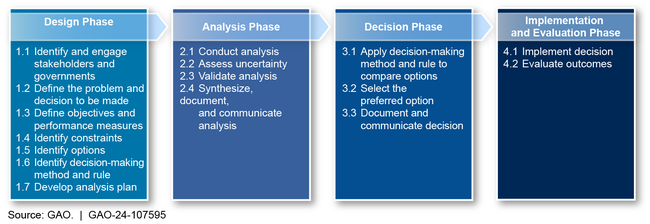Environmental Hazards: A Framework for Risk-Informed Decision-Making
Fast Facts
The U.S. government is liable for the cost of cleaning up contamination left over from mining, energy production, and more—estimated at $645 billion in FY 2023. As agencies fund and complete environmental hazard cleanups, they're often faced with complex decisions.
In this Q&A report, we share our framework that agencies can use to make these decisions effectively. The framework helps agencies prioritize activities while balancing factors like cost with environmental and health risks. It also ensures that agencies engage with communities, governments, and others that can influence decisions or will be affected by them.

Highlights
What GAO Found
GAO’s framework provides an approach for decision-making that considers trade-offs among risks to human health and the environment, cost, and other factors in the face of uncertainty and considers diverse stakeholder and government perspectives. The framework can be applied to many scales and types of decisions about environmental hazards such as air and water pollution, nuclear and hazardous waste management, and workplace exposure to toxic materials.
Agencies that manage or oversee federal decision-making processes related to human health and environmental risks posed by environmental hazards can use the framework as a guide for ensuring that these processes result in risk-informed decisions that are effective and credible.
The framework consists of four broad phases and each phase comprises several steps.
Phases and Steps of the Risk-Informed Decision-Making Framework for Environmental Hazards

Why GAO Did This Study
Agencies across the federal government must make decisions about how to best use taxpayer dollars to reduce risks to human health and the environment posed by environmental hazards like polluted soil and water. For example, federal agencies must decide how to best clean up legacy contamination at sites across the country and how to address the presence of chemicals and other hazards in the environment. These decisions range in scale and complexity, but agencies often need to balance the benefits of reducing human health and environmental risks with the costs of doing so. The U.S. government’s environmental liability—the estimated cost to the federal government of cleaning up environmental contamination from past activities—was $645 billion in fiscal year 2023 and is expected to continue to grow.
Decisions about how to address human health and environmental risks posed by environmental hazards are informed by—but not solely based on—risks and costs. Agencies must also weigh and balance other factors such as legal and regulatory requirements and the diverse views of those interested in or affected by the decision.
To help agencies make effective and credible decisions about environmental contamination and other hazards, GAO developed a framework for risk-informed decision-making. This report presents an updated version of the risk-informed decision-making framework GAO issued in September 2019 in GAO-19-339.
For more information, contact Nathan Anderson at (202) 512-3841 or AndersonN@gao.gov.
